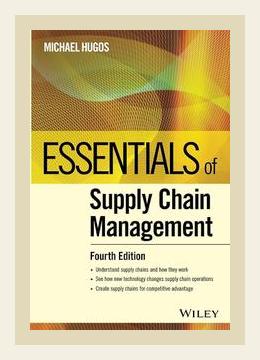Operations and Supply Chain ManagementProcess Improvement
Introduction
Michael H. Hugos’ “Essentials of Supply Chain Management,” published in 2003, provides a comprehensive guide to understanding and improving supply chain processes. The book covers essential concepts, strategies, and practical advice aimed at enhancing overall process efficiency and organizational performance. Hugos uses concrete examples to illustrate his points and offers actionable insights for readers.
1. Understanding the Supply Chain Basics
Hugos starts by defining key supply chain concepts and terminologies. He breaks down the supply chain into its fundamental components: suppliers, manufacturers, distributors, retailers, and customers.
Action: Identify all the key components in your own supply chain. Make a list of suppliers, manufacturers, distributors, retailers, and customers to understand the entirety of the process.
Example: Hugos explains the importance of understanding these components using Dell Computers’ direct-to-consumer model. Dell bypasses traditional retail channels, reducing costs and delivery time.
Action: Evaluate if it is feasible to adopt a direct-to-consumer model in your business and identify potential cost and time savings.
2. Importance of Supply Chain Integration
The book emphasizes the significance of integrating various components of the supply chain for better coordination and efficiency. Integration ensures smooth information flow, reducing delays and misunderstandings.
Action: Implement an integrated information system (like ERP software) that allows seamless communication across all sections of the supply chain.
Example: Procter & Gamble’s integration with Walmart using Vendor Managed Inventory (VMI) systems. This system allows P&G to monitor Walmart’s inventory levels and ship products directly when needed.
Action: Assess your current inventory management system and explore partnerships where VMI could be mutually beneficial.
3. Supply Chain Strategy
Hugos advises that firms must align their supply chain strategy with their business strategy. This includes decisions related to production, outsourcing, inventory management, and logistics.
Action: Develop a supply chain strategy document that aligns with the broader business objectives.
Example: Zara’s agility in its supply chain strategy allows the brand to rapidly respond to fashion trends, keeping inventory levels low and turnover high.
Action: Implement strategies to reduce cycle time and increase responsiveness to market changes.
4. Demand Forecasting
Accurate demand forecasting is crucial for effective supply chain management. Hugos discusses various forecasting methods, including qualitative and quantitative approaches.
Action: Use a combination of historical sales data and market analysis to improve demand forecasting accuracy.
Example: Starbucks uses historical data, seasonal trends, and local events to forecast demand and adjust inventory levels accordingly.
Action: Incorporate local events and seasonal trends into your demand forecasting models.
5. Inventory Management
Effective inventory management balances the cost of holding inventory against the need to meet customer demand promptly.
Action: Implement Just-in-Time (JIT) inventory systems to reduce holding costs and increase efficiency.
Example: Toyota’s implementation of JIT has minimized excess inventory, reduced waste, and increased overall production efficiency.
Action: Perform an audit of your current inventory levels and identify areas where JIT can be applied.
6. Supply Chain Technology
Hugos discusses the role of technology in modern supply chains, highlighting tools like ERP systems, supply chain management software, and emerging technologies such as RFID.
Action: Evaluate and invest in supply chain technologies that improve visibility and efficiency.
Example: Wal-Mart’s use of RFID technology to track inventory in real-time, reducing losses and ensuring products are available when needed.
Action: Explore the feasibility of implementing RFID or other tracking technologies in your supply chain.
7. Performance Metrics
Measuring performance is critical for continuous improvement. Hugos introduces key performance indicators (KPIs) for supply chains, such as inventory turnover, order accuracy, and lead time.
Action: Establish a set of KPIs to regularly measure and monitor supply chain performance.
Example: Amazon measures its supply chain performance using metrics like order accuracy and delivery times, enabling continuous refinement.
Action: Regularly review KPI data and hold periodic reviews to identify areas for improvement.
8. Risk Management
Supply chains face various risks, including supply disruptions, demand fluctuations, and logistical challenges. Hugos discusses strategies for risk mitigation.
Action: Develop a risk management plan detailing potential risks and mitigation strategies.
Example: Cisco’s risk management practices include dual sourcing and maintaining strategic inventory reserves to manage supply disruptions.
Action: Identify critical components in your supply chain and develop contingency plans for potential disruptions.
9. Supplier Relationships
Building strong relationships with suppliers ensures better collaboration, reliability, and performance. Hugos emphasizes the importance of partnership and communication.
Action: Foster long-term relationships with key suppliers through regular communication and mutual support.
Example: Honda’s partnership with suppliers focuses on collaboration and mutual growth, resulting in reliable and high-quality supply chains.
Action: Organize regular meetings and joint projects with key suppliers to build trust and collaboration.
10. Sustainable Supply Chain Practices
Sustainability is increasingly vital in supply chain management. Hugos encourages businesses to consider environmental and social impacts.
Action: Evaluate your supply chain for sustainability and implement practices that reduce environmental impact.
Example: IKEA’s commitment to sustainability includes sourcing materials responsibly and reducing waste, highlighting its dedication to sustainable practices.
Action: Conduct a sustainability audit and develop initiatives that promote responsible sourcing and waste reduction.
Conclusion
“Essentials of Supply Chain Management” by Michael H. Hugos offers a well-rounded overview of the principles, strategies, and best practices in supply chain management. By following Hugos’ advice and utilizing the actionable steps provided, businesses can significantly enhance their supply chain efficiency and overall performance. The book remains a crucial resource for anyone looking to understand and improve supply chain processes in the realm of process improvement.
